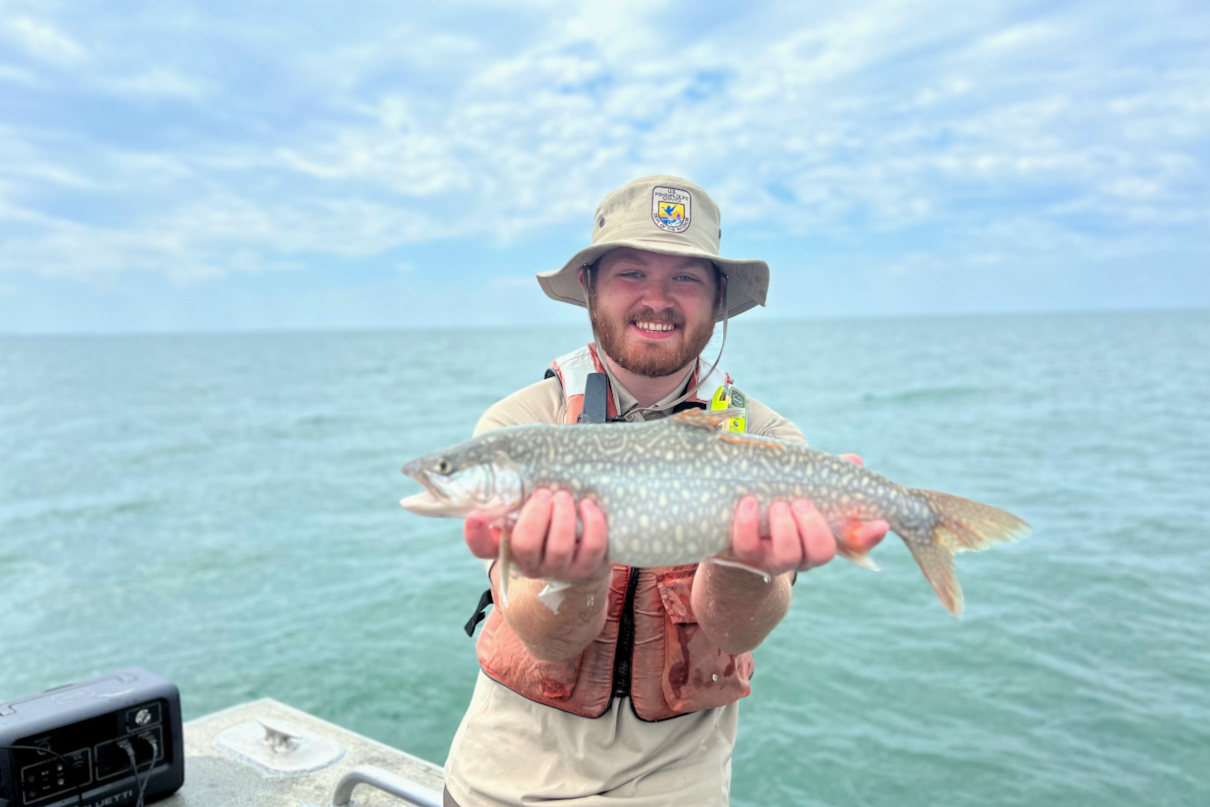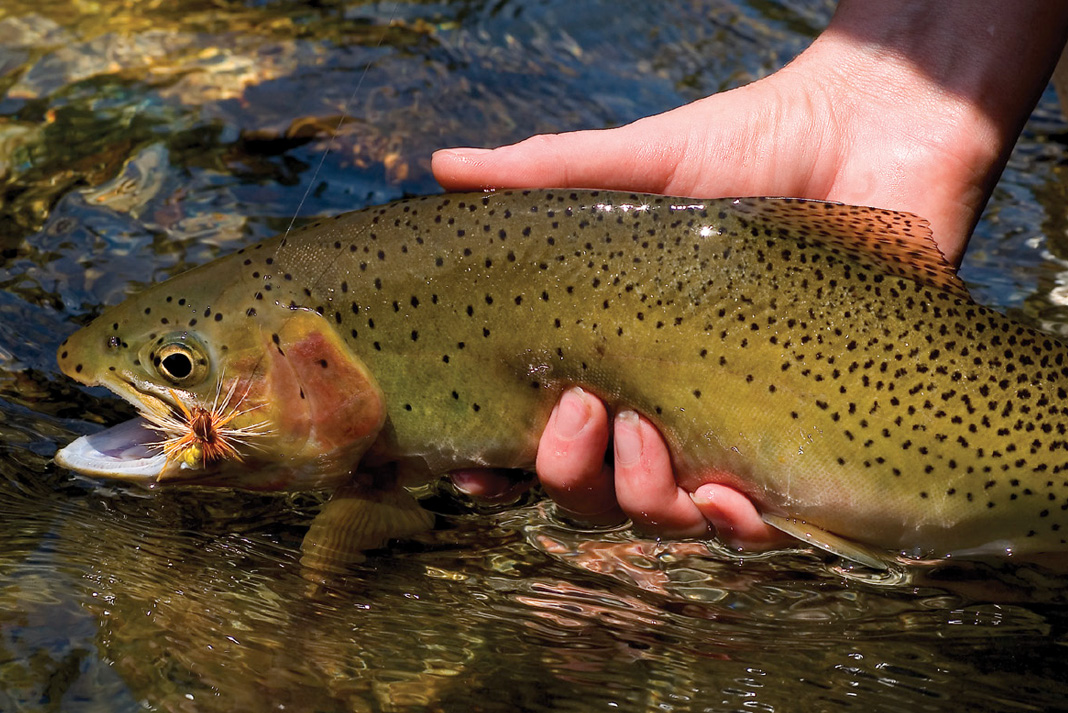I’ve been around trout from coast to coast, through research, conservation work, and fly fishing, for most of my life. Uncovering the intricacies of these species—where they can survive, how they’re distributed, and the ways they’ve developed American angling, all play into my love for a fish that for its popularity has a lot more than meets the eye.
The various species of salmonids commonly referred to as trout are found on six continents. They occupy waters from far north tundra lakes to near-inhospitable desert streams. The trout near you may be Ice Age relics, specialized over thousands of years to survive in the trails of retreating glaciers. Others are transplants brought from states or seas away, put into just the right waters where they can establish wild, non-native populations. Still more are seasonal occurrences, appearing in your local lakes and streams as representatives of the most heavily stocked fish in the country.
From an angler’s perspective, understanding the life history of these animals is crucial to finding them across different waters and seasons. This guide will give a very broad view of popular American trout, how to identify them, and where they can be found.
Identifying the major types of trout

Brook trout
Long before recreational angling of largemouth bass, there was a time when the brook trout was the most popular sport fish in the country. The early years of the United States saw anglers take a special interest in the plentiful native trout (which is actually a species of char) populations of the East. Ritzy fishing clubs sprang up on the best waters, attracting figures like Daniel Webster and Grover Cleveland. Their days of national domination are now long over, but the allure of a stunning colored brookie in the net still brings anglers to their waters.
Identifying keys
- Pale yellow vermiculations (irregular, wavy lines) along dorsal
- Red spots surrounded by blue halos laterally
- Very tiny, almost indistinguishable scales
Habitat and behavior
Brook trout need cold, clean water to thrive. In their American native range of the northeast, deep lakes and small, undeveloped streams are mostly what remain of suitable habitat. Brookies are optimistic feeders in prime conditions and will feed on anything readily available.
Spawning takes place between September and October. Although this often occurs in streams, brook trout also can spawn successfully in lakes—an ability many other trout species do not possess.
Like almost all of the trout covered in this guide, brook trout take full advantage of what their habitat has to offer, leading to varied behavior. Fish with proper access may migrate for food or thermal refuge, making their habits predictable throughout the seasons.

Cutthroat trout
In 1805, below the Missouri River’s Great Falls, the Lewis and Clark expedition recorded their first trout species. Onchorhynchus clarkii lewisi, more commonly referred to as the westslope cutthroat, is just one member of the West’s highly diverse array of cutthroat trout species. Besides lake trout, the historical distribution of cutthroat trout ranges further than any other North American trout or salmon. From mountain stream dry fly sippers to 20-pound lake-dwelling carnivores, the varied existences and forms of the cutthroat are as captivating as the American West landscapes they occupy.
Identifying keys
- The great range of diversity in cutthroat trout species means that it is difficult to categorize a fish by a single characteristic besides genetic markers
- A typically bright red slash beneath the jaws, though not present in all cutthroat, is the most common identifier
Habitat and behavior
Cutthroat trout occupy a range of western waters from Oregon’s temperate rainforests to Nevada’s high desert. Though sensitive to temperature and poor water quality, certain species have adapted to withstand tough natural environmental conditions while still thriving.
Spawning occurs in the spring, with some species migrating from larger lakes or rivers to reproduce. Fluvial and lacustrine cutthroat, like other species of trout with similar life histories, have the potential to reach impressive sizes. Nevada’s Pyramid Lake, for example, is home to some of the largest cutthroat on the planet, with fish over 40 pounds recorded.

Rainbow trout
What is likely the heaviest-stocked of the trout species in America originates from coastal drainages between southern California and Alaska. More specifically, unless you live within that range, the rainbow trout you catch are likely descendants of populations from just a handful of river systems in California and Oregon.
The mesmerizing colors, wide artificial distribution, and success in translating their migratory life histories to new waters make rainbows a popular target for anglers nationwide. Although the full Oncorhynchus mykiss species contains fish native to much further inland and south of the aforementioned range, we’ll stick to just covering the wider spread coastal rainbow trout.
Identifying keys
- Metallic silver or brass body coloration with a flash of pink or red along the lateral line
- Rosy coloring often extends to the gill plate
- Heavy spotting above and below the lateral line and into the dorsal fin and tail
Habitat and behavior
Stream-resident coastal rainbows comfortably occupy rivers in lakes in their native range and beyond, naturally keying in on various invertebrates, eggs, and small fish. As demonstrated in established wild populations across North America, these hardy subspecies can establish themselves in systems where other trout on this list would struggle.
As popular as the commonly stocked “‘bows” are, anglers hold a great deal of reverence around the other form of coastal rainbows—steelhead. This migratory version takes advantage of the massive potential of larger water bodies to grow quicker and to larger sizes than they can achieve just in streams. This life history is also seen in ocean-going fish smolt stocked outside their range in places like the Great Lakes, with great success. The timing of these runs differ on location—true ocean-going steelhead return almost every month of the year, while lake run fish returns in the East tend to be a colder-weather fishery.

Brown trout
Brown trout were brought to North America from Germany and the U.K. in the late 1800s. They have become well established in rivers and lakes both through self-sustaining populations and continued stocking. The fish’s selective feeding habits and predatory behavior quickly produced a new breed of American brown trout angler enamored with the challenge of a wary but aggressive adversary.
Identifying keys
- Black, red, or orange spots on a brownish yellow body
- The only species of trout with red or orange spots on the adipose fin
Habitat and behavior
Stocking of aggressive brown trout directly resulted in extirpation of native fish. Many larger trout systems that historically held rainbows, cutthroat, or brook trout were taken over by browns and have remained that way for over a century.
In streams, brown trout will often orient themselves to covered banks where they can ambush prey. They have excellent eyesight and are well-adapted to feeding at night. Lake-dwelling browns can grow rapidly after they’ve achieved a certain size, upgraded their diet, and usually moved to deeper water.
Brown trout are fall spawners and will seek out gravelly areas in which to dig redds and lay eggs. Spawns can involve migratory runs from fish moving out of lakes or large river systems in search of appropriate substrate—a behavior that, as with other trout species with the same life histories, makes them easier to intercept as anglers.

Lake trout
Lakers are one of the largest salmonids in North America and a staple target species for coldwater lake anglers. These supersized char are aggressive, predatory, and well distributed across the country’s northern systems. When conditions align, these often deep water dwellers can offer excellent opportunities for huge fish out of small craft.
Identifying keys
- Gray/green body with large, pale spots
- Well-developed teeth
- A deeply forked tail
Habitat and behavior
A major key to the lake trout’s size lies in its age. Their preference for cold, high-oxygenated water can result in very short growing seasons, occasionally creating the perfect opportunity for a long-lived fish to slowly get huge.
Young lake trout feed on plankton and midge larvae until they reach a size where they can prey on other fish. As they get older (and larger), whitefish, suckers, and more are added to the menu.
Lake trout have been recorded feeding at depths of over 1000 feet. They will follow food to deeper water, or stay there to avoid warmer summer temperatures higher in the water column. Although they hold a reputation as a deep water fish, lakers will spend ample time in the shallows for parts of the year. When springtime surface water temperatures are still cool, lake trout will feed just under the surface before warming water drives them down again. During spawn in the fall, they will return to shallower rocky bottoms to deposit and fertilize eggs.
A note on the organization of this guide
Common names and taxonomic classifications don’t go hand in hand here. Being an angler’s guide, we’ve broken trout into five somewhat unofficial but regularly named groups: rainbow trout, cutthroat trout, brown trout, lake trout, and brook trout. There are dozens of strains and subspecies of each “trout” across North America, but for this guide we’ve pooled them under its broader name, dividing them up by different behaviors and characteristics when necessary.
The broad groupings listed in this guide just scratch the surface of the fish’s various morphologies and behavior, but it’s a road map to unlocking more specific secrets of the fisheries you visit. Whether you’re chasing the truck stocking rainbows on local ponds, searching for a big lake trout bite after ice out, or anything in between, understanding the wide world of trout preferences and abilities will give you the intuition to be successful on the water—and maybe more appreciation for a common but sometimes underrated species.








